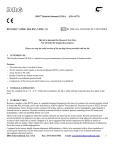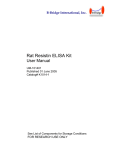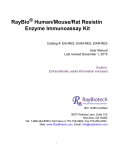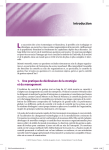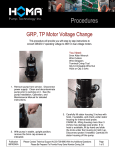Download Y - B-Bridge International, Inc.
Transcript
B-Bridge International, Inc. Human Resistin ELISA Kit User Manual UM-100301 Published 01 August 2004 Catalog# K1003-1 See List of Components for Storage Conditions FOR RESEARCH USE ONLY Human Resistin ELISA 04152013 Human Resistin ELISA Kit User Manual Table of Contents I. II. III. IV. V. VI. VII. VIII. IX. Introduction and Protocol Overview List of Components Additional Materials Required Reagent Preparation and Storage Sample Preparation Human Resistin ELISA Protocol Calculation of Results Troubleshooting Guide References 3 5 6 7 8 9 11 12 13 Notice to Purchaser This product is to be used for Research Purposes Only. It is not to be used for Drug or Diagnostic Purposes, nor is it intended for Human Use. B-Bridge products may not be resold, modified for resale, or used to manufacture commercial products without the express written consent of B-Bridge International, Inc. EXCEPT AS OTHERWISE EXPRESSLY SET FORTH IN THIS USER MANUAL, B-BRIDGE DOES NOT MAKE ANY REPRESENTATION OR WARRANTIES OR CONDITIONS OF ANY KIND, EITHER EXPRESSED OR IMPLIED, WITH RESPECT TO THE PRODUCTS, OR INFORMATION DISCLOSED HEREUNDER, INCLUDING, BUT NOT LIMITED TO, THE IMPLIED WARRANTIES OF MERCHANTABILITY, FIT FOR A PARTICULAR PURPOSE, OR NONINFRINGEMENT OF THE INTELLECTUAL PROPERTY RIGHTS OF THIRD PARTIES. 2004, B-Bridge International, Inc. All Rights Reserved. 2 B-Bridge International, Inc. Human Resistin ELISA 04152013 Human Resistin ELISA Kit User Manual I. Introduction and Protocol Overview Resistin, a product of the RSTN gene, is a peptide hormone belonging to the class of cysteine-rich secreted proteins which are termed the RELM family, and is also described as ADSF (Adipose Tissue-Specific Secretory Factor) and FIZZ3 (Found in Inflammatory Zone). Human resistin contains 108 amino acids as a pre-peptide. Its hydrophobic signal peptide is cleaved before it is secreted. Resistin circulates in human blood as a dimeric protein consisting of two 92 amino acid polypeptides, which are disulfide-linked via Cys26. Much of the early investigations about the resistin molecule are based on the mouse model. Resistin produced and secreted primarily by adipocytes in mice, acts on skeletal muscle myocytes, hepatocytes and adipocytes themselves so that it reduces their sensitivity to insulin. Steppan et al. have suggested that resistin suppresses the ability of insulin to stimulate glucose uptake. Other studies have shown that mouse resistin increases during the differentiation of adipocytes, but it also seems to inhibit adipogenesis. Compared to the mouse model, human adipogenic differentiation is likely to be associated with a down regulation of resistin gene expression. On the other hand, resistin was found to be expressed at high levels in human monocytes, macrophages, and bone marrow. Recent investigations have shown that human resistin is correlated with metabolic syndrome and obesity-related disorders. Malo et al. have reported that resistin levels are positively associated with waist circumference, tumor necrosis factor-α, and insulin resistance assessed by the homeostasis model and inversely correlated with total cholesterol, HDL cholesterol, and LDL cholesterol. Moreover, Sadhasiv et al. found a positive correlation of SAT (subcutaneous adipose tissue) resistin mRNA expression with serum resistin, BMI and insulin resistance (HOMA index). Based on the above reports human resistin might be an important marker that acts as the link between obesity and insulin resistance. Resistin can play a role also in inflammation processes and in atherosclerosis. The B-Bridge Human Resistin ELISA Kit is designed to measure the concentration of human resistin (homodimeric) in human serum, plasma (EDTA, citrate, heparin), or tissue culture medium. 3 B-Bridge International, Inc. Human Resistin ELISA 04152013 Human Resistin ELISA Kit User Manual The principle of the assay is shown in Figure 1. Standards or samples are incubated in microtiter wells coated with a goat polyclonal anti-human resistin antibody. The wells are washed, and a biotin-labeled rabbit polyclonal anti-human resistin antibody is added and incubated with the captured resistin. After a thorough wash, streptavidin-horseradish peroxidase conjugate is added. Following subsequent incubation and washing, the bound conjugate is allowed to react with the substrate H2O2-tetramethylbenzidine (TMB). The reaction is quenched by addition of acidic solution and absorbance of the resulting product is measured at 450 nm. The absorbance is proportional to the concentration of resistin. A standard curve is constructed by plotting absorbance values versus resistin concentrations of calibrators, and concentrations of unknown samples are determined using this standard curve. Biotin-labeled rabbit polyclonal anti-human resistin antibody Resistin ♦♦ ♦ ♦ Streptavidin-HRP Conjugate • • • • YY YY 1st Reaction Assay Principle E E 2nd Reaction Substrate H2O2-TMB E 3rd Reaction Color Development E • • • ♦♦ ♦ Y YY ♦♦ ♦ YY Y E Y YY YY Y • • • ♦♦ ♦ E YY Y YY Y E E E • • • ♦♦ ♦ Y YY Figure 1. YY Y A goat polyclonal anti-human resistin antibody coated plate 4 B-Bridge International, Inc. Human Resistin ELISA 04152013 Human Resistin ELISA Kit User Manual II. • List of Components Store all components at 2-8°C. DO NOT FREEZE. 1 10X WASH SOLUTION 1 Bottle (100 ml) 2 1X SAMPLE DILUENT . PRIMARY ANTIBODY-COATED PLATE 1 Bottle (20 ml) 3 1 Plate One plate holds 12x8-well strips (96 wells), with adsorbed Goat Polyclonal Anti-Human Resistin Antibody. Plate is provided in a resealable foil pouch with desiccant. 4 HUMAN RESISTIN MASTER STANDARD 1 Vial Lyophilized 5 QUALITY CONTROL 2 Vials High and Low, lyophilized 6 BIOTINYLATED SECONDARY ANTIBODY SOLUTION 1 Bottle (13 ml) Rabbit Polyclonal Anti-Human Resistin Antibody, Biotin Labeled 7 CONJUGATE SOLUTION 1 Bottle (13 ml) Streptavidin-Horseradish Peroxidase Conjugate 8 SUBSTRATE SOLUTION 1 Bottle (13 ml) H2O2Tetramethylbenzidine 9 STOP SOLUTION 1 Bottle (13 ml) (0.2M H2SO4) MSDS forms are available on our website—please visit www.b-bridge.com 5 B-Bridge International, Inc. Human Resistin ELISA 04152013 Human Resistin ELISA Kit User Manual III. Additional Materials Required The following materials are required, but not supplied: • Graduated cylinder • Micropipettor(s) and disposable pipette tips • Null strips for 96-well plate • 96-well plate washer • Paper towels or absorbent paper • Plate reader capable of measuring absorbance at a wavelength of 450 nm • Orbital microplate shaker capable of approximately 300 rpm • Tubes for sample dilutions • Deionized water 6 B-Bridge International, Inc. Human Resistin ELISA 04152013 Human Resistin ELISA Kit User Manual IV. Reagent Preparation and Storage Allow all the reagents to equilibrate at room temperature (25°C) prior to the start of the reagent preparation. 1. 1X Wash Solution Prepare 1X Wash Solution by mixing 100 ml of 10X Wash Solution with 900 ml of deionized water or equivalent. After preparation, store 1X Wash Solution at 2-8°C. The diluted Wash Solution is stable for 1 month at 2-8°C. 2. Human Resistin Standard Solution Reconstitute the Resistin Master Standard according to the Certificate of Analysis. Let the lyophilized standard dissolve in 1X Sample Diluent for at least 15 minutes prior to serial dilutions for the assay. Prepare each Resistin Standard (20 ng/ml, 10 ng/ml, 5 ng/ml, 2 ng/ml, and 1 ng/ml) by serially diluting the stock Resistin Master Standard Solution (50 ng/ml) with 1X Sample Diluent as shown in the table. Use the reconstituted Resistin Standard (50 ng/ml) and 1X Sample Diluent for the 50.0 ng/ml and 0 ng/ml standard solutions, respectively. Table 1: Serial Dilution of Resistin Standards Master Standard Vol. Master Std. Stock 500 µl of Master Std. Stock 500 µl of 20 ng/ml Std. 500 µl of 10 ng/ml Std. 500 µl of 5 ng/ml Std. 500 µl of 2 ng/ml Std. 1X Diluent 750 µl 500 µl 500 µl 750 µl 500 µl Concentration 50 ng/ml 20 ng/ml 10 ng/ml 5 ng/ml 2 ng/ml 1 ng/ml Further dilute the serial diluted Standard Solutions 1:3 prior to use by mixing 100 µl of Standard Solutions with 200 µl of Sample Diluent for duplicates. Do not store the diluted standard solutions. Reconstituted and stock Resistin Standard Solutions (50 – 1 ng/ml) should be aliquoted and frozen at -20°C for 3 months. Do not store the dilut ed (1:3) standard solutions. 3. Quality Controls Reconstitute the Quality Controls with 350 µl Sample Diluent, mix and let sit for 30 minutes at room temperature. Further dilute the reconstituted Quality Controls 1:3 with Sample Diluent prior to use (50 µl control + 100 µl Sample Diluent for singlets or 100 µl Quality Control + 200 µl Sample Diluent for duplicates). Reconstituted Quality Controls are stable until the expiration date at 2-8°C. Do not store the 1:3 diluted Qualit y Controls. Refer to the Certificate of Analysis for Quality Control concentrations. The Quality Controls serve to confirm that the kit works in accordance with Certificate of Analysis and the ELISA test was carried out properly. 7 B-Bridge International, Inc. Human Resistin ELISA 04152013 Human Resistin ELISA Kit User Manual V. Sample Preparation Allow all the reagents to equilibrate at room temperature (25°C) prior to the start of the sample preparation. Samples should be assayed immediately after collection or stored at -20°C or -70°C for long term. Thoroughly mix thawed samples prior to assaying. Aliquot samples to avoid repeat freeze thaw cycles. Avoid using hemolyzed or lipemic samples. Serum and plasma samples: 1. For Assaying Samples in singlets: Mix 50 µl of samples with 100 µl of 1X Sample Diluent. 2. For Assaying Samples in duplicates: Mix 100 µl of samples with 200 µl of 1X Sample Diluent. Do not store 1:3 diluted samples. Tissue culture supernatant: Quantity of protein in cell culture supernatant may vary by cell line (e.g. HIB 1B, LS14 etc.), we recommend running several dilutions to determine optimal dilution for the assay. Undiluted culture supernatant can also be assayed. Select a few samples to determine optimal dilution for assaying. 1. Undiluted tissue culture supernatants 2. Dilute 1:3 with 1X Sample Diluent: 50µl of sample + 100 µl of Sample Diluent 3. Dilute 1:6 with 1X Sample Diluent 25µl of sample + 125 µl of Sample Diluent Choose suitable dilution and repeat the assay with all samples. 8 B-Bridge International, Inc. Human Resistin ELISA 04152013 Human Resistin ELISA Kit User Manual VI. Human Resistin ELISA Protocol Note: Allow all reagents to equilibrate at room temperature (25°C) prior to the start of the assay and prepare 1X Wash Solution, Quality Controls, Resistin Standards, and samples as described in the previous sections. 1. Remove Primary Antibody-Coated Plate from its foil pouch. Remove any unneeded strips from the plate frame, reseal them in the foil pouch, and return the foil pouch to 2-8°C. If a 96-well plate washer is used, the plate frame should be completely filled with wells by adding as many null strips as necessary. Identify well position(s) for each sample on a data sheet or plate map. 2. Add 100 µl of diluted Standards, Quality Controls, Sample Diluent (blank) and samples to the appropriate number of antibody-coated wells. Every plate must include the standard series to properly correlate the sample readings. 3. Cover plate(s) securely and incubate at room temperature (25°C) for 60 minutes on an orbital microplate shaker at ca. 300 rpm. 4. After incubation, wash the plate(s) 3 times with Wash Solution as follows: a. Completely aspirate the liquid from the wells using a plate washer. b. Fill each well with 1X Wash Solution (~350 µl/well) and immediately aspirate. Avoid overflow. c. Repeat Step 4b two more times for a total of three washes. d. Invert the plate(s) and gently tap on a clean absorbent towel. 5. Dispense 100 µl of the Biotinylated Secondary Antibody Solution into each well. 6. Cover plate(s) securely and incubate at room temperature (25°C) for 60 minutes on an orbital microplate shaker at ca. 300 rpm. 7. Repeat the wash procedure described in step 4. 8. Dispense 100 µl of Conjugate Solution into each well. 9. Cover plate(s) securely and incubate at room temperature (25°C) for 60 minutes on an orbital microplate shaker at ca. 300 rpm. 10. Repeat the wash procedure described in step 4. 11. Dispense 100 µl of Substrate Solution into each well. Avoid exposing the microtiter plate to direct sunlight. Covering the plate with aluminum foil is recommended. 12. Cover plate(s) securely and incubate at room temperature (25°C) for 10 minutes with no shaking. The incubation time may be extended up to 20 minutes, if the reaction temperature is below 20°C. 13. Dispense 100 µl of Stop Solution into each well. The plate should be read immediately. 14. Read the plate at 450 nm using a plate reader with reference wavelength 630 nm. Subtract the readings at 630 nm from the readings at 450 nm. 9 B-Bridge International, Inc. Human Resistin ELISA 04152013 Human Resistin ELISA Kit User Manual Note: If some samples and standards have absorbances above the upper limit of your microplate reader, perform a second reading at 405 nm. A new standard curve constructed using the values measured at 405 nm is used to determine resistin concentrations of off scale standards and samples. Figure 2. Flow Chart of Assay Procedure Goat Polyclonal Anti-Human Resistin Antibody Coated Plate Diluted Standards, Quality Controls, Sample Diluent and Samples 100 µL 1st Reaction: 25°C, 60 min, 300 rpm Prepare Wash Solution Wash x 3 (350 µL x 3) Biotinylated Rabbit Polyclonal Anti-Human Resistin Antibody Solution 100 µL 2nd Reaction: 25°C, 60 min, 300 rpm Wash x 3 (350 µL x 3) Streptavidin-HRP Conjugate Solution 100 µL 3rd Reaction: 25°C, 60 min, 300 rpm Wash x 3 (350 µL x 3) Substrate Solution 100 µL Color Development: 25°C, 10 min, no shaking Stop Solution 100 µL Read Absorbance at 450 nm 10 B-Bridge International, Inc. Human Resistin ELISA 04152013 Human Resistin ELISA Kit User Manual VII. Calculation of Results 1. Subtract the mean absorbance value of the 0 ng/ml blank from each mean absorbance value of the standard series and samples tested (Net Absorbance). 2. Plot the log of known concentrations of each standard and the calculated Net Absorbances on the X-axis and Y-axis, respectively. Fit an appropriate regression curve to the plotted points. 3. Determine the resistin concentrations of the samples by interpolation of the regression curve formula. Figure 3. Typical Standard Curve Human Resistin ELISA Standard Curve 3.5 3.0 Absorbance (450 nm) 2.5 2.0 1.5 1.0 0.5 0.0 1 10 100 Concentration of Human Resistin (ng/ml) 11 B-Bridge International, Inc. Human Resistin ELISA 04152013 Human Resistin ELISA Kit User Manual VIII. 1. Troubleshooting Guide Lack of signal or weak signal in all wells Possible explanations: • • • • 2. High signal and background in all wells Possible explanations: • • • 3. Improper or inadequate washing; be certain that all wash volumes and repetitions were correct. Decrease color development time. The plate should be read within 5 minutes of stopping the color development High background in sample wells only Possible explanations: • 4. Omission of a reagent or a step. Improper preparation or storage of a reagent. Assay performed before reagents were allowed to come to 25°C. Plate reader did not perform well. Sample concentration was too high. Weak signal in sample wells only Possible explanations: • Sample concentration was too low. 12 B-Bridge International, Inc. Human Resistin ELISA 04152013 Human Resistin ELISA Kit User Manual IX. References Banerjee R.R., Lazar M.A.: Dimerization of resistin and resistin–like moleules is determined by a single cystein. The Journal of Biological Chemistry. 276, 25970-25973, (2001) Fasshauer M. at al.: Tumor Necrosis Factor α Is a Negative Regulator of Resistin Gene Expression and Secretion in 3T3-L1 Adipocytes. Biochemical and Biophysical Research Communications. 208, 1027-1031, (2001) Hartman H.B., Lazar M.A. at al.: Mechanisms Regulating Adipocyte Expression of Resistin. The Journal of Biological Chemistry. 277 (22), 19754-19761, (2002) Juan CC. at al.: Suppressed Gene Expression of Adipocyte Resistin in an Insulin-resistant Rat Model Probably by Elevated Free Fatty Acids. Biochemical and Biophysical Research Communications. 289, 1328-1333, (2001) Kim KH. et al.: A Cysteine-rich Adipose Tissue-specific Secretory Factors Inhibits Adipocte Differentiation. The Journal of Biological Chemistry. 276 (14), 11252-11256, (2001) Steppan C.M., Lazar M.A.: Resistin and obesity-associated insulin resistance. TRENDS in Endocrinology and Metabolism. 13 (1), 18-23, (2002) Steppan C.M. et al.: The Hormone Links Obesity to Diabetes. Nature. 409, 307-312, (2001) Steppan C.M. at al.: A Family of Tissue-specific Resistin-like Molecules. Proc. Natl. Acad. Sci. USA. 98 (2), 502-506, (2001) Way J.M. et al.: Adipose Tissue Resistin Expression Is Severly Suppressed in Obesity and Stimulated by Peroxisome Proliferator-activated Receptor γ Agonists. The Journal of Biological Chemistry. 276 (28), 25651-25653, (2001) 13 B-Bridge International, Inc. Human Resistin ELISA 04152013














